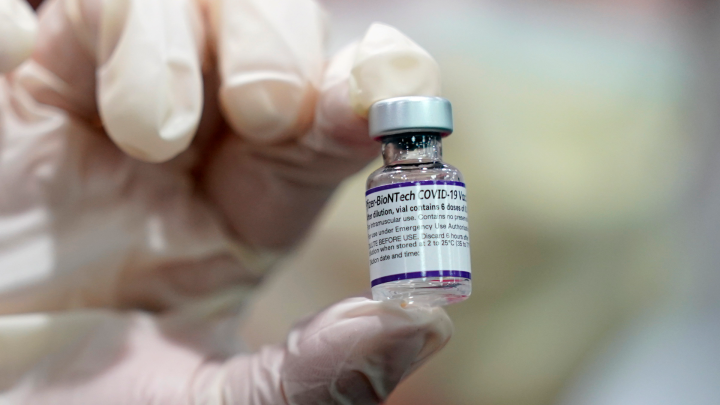With COVID-19 vaccine deadlines looming for staff at both of Hamilton’s hospital networks, each are reporting close to 90-plus per cent compliance with those who have revealed their status as of Tuesday.

Hamilton Health Sciences (HHS) says close to 12,000 staffers (92 per cent) of the 98 per cent who have disclosed their position have been fully vaccinated with St. Joe’s saying 90 per cent of its roughly 5,900 workers have had two shots.
Over 99 per cent of physicians at St. Joe’s say they have completed their series of doses.
For St. Joe’s, it leaves about 6.6 per cent of their workers status either not known, not vaccinated or with medical or religious exemptions. For HHS, it’s roughly 9.1 per cent.
Combined, both hospital agencies have about 1,500 of their workforce in limbo.
Unpaid leaves of absences and even dismissal await those who do not become fully vaccinated in the next month, according to the agency’s executives. HHS has set a deadline of Nov. 30 for staff to meet its vaccine mandate, while St. Joe’s says it has yet to solidify its cut-off date.
Despite many health-care workers opting to get fully vaccinated against COVID-19, the head of the Registered Nurses Association of Ontario (RNAO) is suggesting that the few who are not could exasperate ongoing staffing shortages across the health-care sector.
Dr. Doris Grinspun told 900 CHML’s Good Morning Hamilton that even with an estimated 80 per cent of the province’s care workers having had two shots, mandates from some health-care networks, like hospitals requiring vaccinations, means there will be some staff that won’t be able to work.
“The problem is that any health-care worker that is not vaccinated can more easily deliver the virus to the workplace, and we cannot afford that. The patients cannot afford that,” Grinspun said.

Get weekly health news
“Health-care workers don’t want to work with health-care workers that are not vaccinated, either. So we are in a crunch in terms of the timelines to get vaccinated.”
The president of a union representing workers in long-term care, hospitals and retirement homes told Global News that current low staffing levels are tied to a lot of pre-pandemic issues such as precarious work, low wages and a lack of full-time jobs.
Sharleen Stewart of SEIU Healthcare said vaccine mandates could be the “potential straw that breaks the camel’s back,” since those who don’t meet their employer’s guidelines will likely have to sit out.
“When they take a look at the environment and the dedication and the respect they get from their employers and government, they don’t see that as reason enough right now to convince themselves quite frankly to take the vaccine,” Stewart said.
A late September HHS staff town hall revealed the ongoing effects the pandemic continues to have on Hamilton’s hospital networks, with overall patient occupancy at its two biggest facilities, Hamilton General and the Juravinski, over 100 per cent.
Hamilton Health Sciences VP and CEO Sharon Pierson told staff that the need for critical care was having a “downstream effect” on the hospital’s resources and, as such, having more staff vaccinated would be critical in navigating through future demand for service.
“The increasing need for vaccinations to rise is essential,” Pierson said.
“Our policy has made it abundantly clear that our expectation is that everyone must be vaccinated to work here.”
Week over week, both HHS and St. Joe’s have reported little change with COVID-19 hospitalizations as the two combined for 29 COVID-19 patients with 12 in intensive care units (ICU). Last Wednesday, the networks reported 28 patients, with 11 in ICU’s.
Grinspun says she does see some good signs for the nursing sector on a whole due to some surges in applicants — like those seen at Queen’s University earlier in 2021 — and the willingness of the RNAO to increase the number applicants it accepts.
However, two-dose vaccinations among the general public will be key in relieving stress on the sector.
“While the vaccine may not completely prevent you from getting the virus, it does really slow down significantly the number of people that go to hospitals and certainly to ICU,” Grinspun said.
“So get vaccinated both for yourself, and to protect the health system and the resources.”
Hamilton's new COVID cases steady week over week
Hamilton public health is reporting little change in its weekly seven-day average of new COVID cases returning positive from local labs.
The city’s mean was 29 as of Wednesday, almost identical to the average of 30 reported the same day last week.
However, active cases have steadily dropped to 188 compared to the 248 a week ago. Over 52 per cent of the city’s active cases involve people under the age 30, down about eight per cent week to week.
With 14 outbreaks closed across the city over in the last seven days, there are now about half as many outbreaks as of Oct. 12.
Last Tuesday, the city recorded 21 outbreaks tied to 119 total cases. As of Tuesday, just nine outbreaks were reported involving 40 total cases.
Outbreaks in the city’s schools have also dropped off, with five ongoing as of Wednesday compared to the 14 reported on Oct. 5.
The number of COVID-19 cases at public schools over the last 14 days is 72 as of Wednesday, with 66 tied to students.
Last week, both the HWDSB and Catholic board reported 122 total cases over 14 days with 111 among students.
Over 79 per cent of the city’s eligible population over 12 years old have had two doses of a COVID-19 vaccine, with over 84 per cent having at least a single shot.
Second shots among all residents in Ontario is at 82.5 per cent as of Tuesday, putting Hamilton behind 30 of the 34 public health units in the province.
The lowest of the two-dose rates are with those aged between 25 and 29 — only 67.3 per cent of those in that demographic have had two doses.











Comments